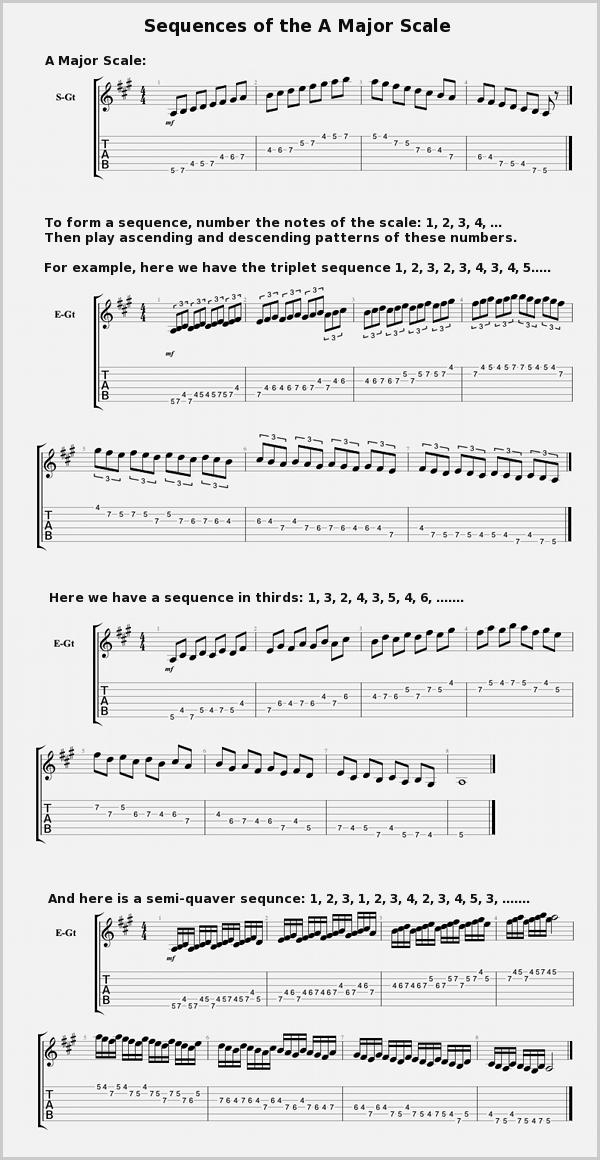Guitar Scale Sequences

It is common when practicing guitar scales to practice them in a sequence.
To look at a couple of common sequences start by numbering the notes of the scale in ascending order:
1, 2, 3, 4, 5, 6, …..
A sequence is then a repeated pattern of these numbers moving up and down the scale.
Some common sequences of guitar scale patterns would be playing the notes of the scale in triplets as:
1, 2, 3, 2, 3, 4, 3, 4, 5, 4, 5, 6, …..
Or you could practice an interval such as thirds, (commonly played as quavers):
1, 3, 2, 4, 3, 5, 4, 6, ….
There are also a number of 4 note sequences that are common such as:
1, 2, 3, 1, 2, 3, 4, 2, 3, 4, 5, 3, 4, 5, 6, 4, ….
or
1, 2, 3, 4, 2, 3, 4, 5, 3, 4, 5, 6, 4, …..
These sequences would often be played in semi-quavers.
There are several benefits of practicing scales in sequences. When you are practicing a scale, you want both the scale pattern and the sound of the scale ingrained into your knowledge so that you do not have to think about the notes of the pattern when you are improvising.
Additionally, you want to ingrain the sound of the scale such that you can hear potential tones to move to in a solo and intuitively be able to know where you can play that tone in your pattern
Practicing a wide range of sequences for each scale you learn will help ingrain your understanding of both the pattern and the sound of the scale.
Additionally, playing small parts of a sequence of a scale is common in soloing, so by practicing these sequences, you can actually play parts of the exact sequences in your solos.
To help your understanding of these sequences above, you can see the tab of a number of these sequences of the A major scale at the top of this article.
It is also useful to practice your scales and sequences over a backing. This helps you learn the sound of the scale in relation to the sort of chords it may be played over.
You can see our complete set of resources on guitar scales at our guitar scales page.

Really helpful
Been playing guitar for 20 years,but never got into lead.I’ve seen my share of lessons,but these are by far the best free lessons I’ve seen.they break it down to LOGICAL sensible chunks of chewable beef.it just makes sense.keep it up:-)
Thanks Matt.
Thanks 4 dis lesson,bt I need more explanation on hw to form links between this notes.
Hi Momoh,
I’m not sure what you need here. Can you rephrase the question?
I think he means that reading the music sheet above you see some of the notes are connected and some are not. so how do you play that differently.
Oh, ok. That’s standard music notation indicating the duration of the notes. In the examples above each note is held the same duration and you play the notes with the connections between them the same as the ones without. I wouldn’t worry too much about the music notation if you’re not used to reading it but rather rely on the tab.
Thanks for this very helpful information, can you share us also the different positions/pattern of scales along the fretboard.
Regards….
It’s really nice and very very simplified….i like….thanks GuitarOrb. But i want u to help m out with all guitar scales including their chat.
Wow this is way better info than what’s on youtube.
Thank you.
my main issue with playing with the back tracking is where do I play the scales IE What fret do I start the root on ???
I was using a tuner and trying to match lets say the blues scale ,and ended up on the12th fret to go along with the back tracking based on sound but an actual way to figure it out would be great…
Hi I have been studying your guitar teaching pages.
I would like to confirm that when reading the tabs you have set out, is the 6th string denoted on the bottom and are the scales showing commencement from the first fret.
Thanks
Graeme.
In the scale diagrams, the 6th string is at the bottom. They can be played at any fret and the fret you play them at will indicate the key. You can read about that in the section: Update: Reading the neck diagrams on the page https://www.guitarorb.com/guitar-scales/
So glad I found your site. I’m an old man but a very young bass player. Though your side is aimed at guitarist I profit too. Thank you.
hi,
just got my gretsrch 6120 hot rod seltzer cleaned up. it’s so fantastic. time for serious woodshedding…
thanks for this scale tutorial, i,ve always just played songs!
t.c. canterbury sierra madre, ca.
Thank you so much! You have a kind and knowledgeable soul.